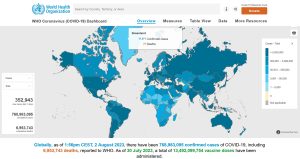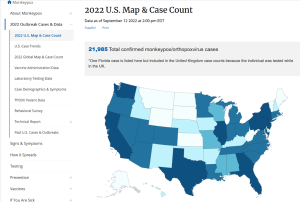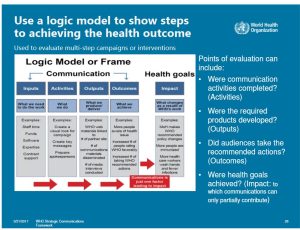Chapter 1: The Importance of Epidemiology
Overview
Most of us do not know a lot about what the term epidemiology means or how far reaching it is. When news focuses on new illnesses, infections, or unidentified causes for outbreaks, we start to remember what we have read, experienced, or heard about from other sources. A frame of reference is the evolving mutation of COVID we see throughout the world. Other diseases we thought were eradicated are showing up sporadically such as Polio, Measles and even Chickenpox. At one point, the World Health Organization (WHO) thought Ebola was stopped, yet it continues to resurface.
Tracking is critical to identifying infections, pandemics, epidemics, endemic illnesses, and even local transmission of illnesses to protect populations by studying and taking measures to reduce spread of diseases that then mutate to more virulent forms.
How do we track, collect data, communicate, manage, and make decisions to respond?
We generally do not associate informatics, interprofessional education and practice , and systems thinking with each other, yet all are closely intertwined in digital information. This chapter will discuss the importance of this as crucial to collaboration and effective engagement across disciplines.
Learning Objectives for This Chapter
- Recognize, access, and interact with informatics tools that are data driven.
- Conceptualize ways in which informatics tools make a difference in educating patients, community, and to prepare for community acquired diseases or infections from a systems approach.
- Explore the roles and communication methods of an interprofessional team.
Activity 1
Epidemiology
Watch the video below.
After watching the video, review the PowerPoint slides provided below the video.
Once you have reviewed the slides, you can fill in the blanks in the statements below.
Activity 2
Mpox
Click on the images for the two Mpox (formerly known as monkeypox) maps and case counts. One is global and the other focuses on the U.S. Once you have explored the maps, work through the “Mpox Prevention & Control Tool” found below.
COVID-19
The following are two images with COVID-19 data. The first image provides COVID-19 data in 2022.
![]()
This image is from July 2023, reported by the World Health Organization.

Activity 3
Interprofessional Teams
Explore the activities section of the World Health Professions Alliance (WHPA) website to see who makes up the interprofessional team and its importance.
What are the levels of providers in our workforce?
Activity 4
Communication & Interprofessional Teams
WHO employs a logic model or frame for the ways it communicates. We must also consider the technology that it uses to reach across the world in varied venues.
WHO Framework at a Glance PowerPoint Slides
How do they communicate across the world and within particular countries?
Each provider has a scope of practice and roles that in some cases overlap and for all cases complement each member of the interprofessional team. The goal is for all to work in coordination respecting and valuing each members’ expertise and contribution. In the public health arena we work with foundational systems for digital information which is communicated to all providers and stakeholders. In tracking diseases and illnesses informatics concepts are critical to the accuracy of data collection and transmission, as we can see from the activities above.
Conclusion:
The world of epidemiology is embedded in every aspect of what we know as informatics, which provides the technological tools with data, science, and computing power to recognize and interact with interprofessionals throughout the world to improve healthcare (HIMSS, 2023).
Education is key to informing our patients, community, healthcare workers, and policymakers of the necessity o fund and support a systems approaches in preparing for community acquired disease.
References
Health informatics. (2023). Wikipedia. https://en.wikipedia.org/wiki/Health_informatics
Saba, V. K., & McCormick, K.A. (2015). Essentials of Nursing Informatics (6th ed). McGraw Hill.
Media Attributions
- COVID picture epidem is licensed under a Public Domain license
- Monkey Poxs World Wide is licensed under a Public Domain license
- Cases in US of Monkey px is licensed under a Public Domain license
- CDC Covid tracker Dec 23 2022
- WHO Coronavirus (COVID-19) Dashboard is licensed under a Public Domain license
- World Health Professions Alliance is licensed under a All Rights Reserved license
- Group of Interprofessional Healthcare Workers is licensed under a CC BY (Attribution) license
- Screenshot 2022-12-31 160159 who is licensed under a Public Domain license
- 1452415.fig.001 © Carney, T. J., & Shea, C. M. is licensed under a CC BY (Attribution) license
The branch of medicine which deals with the incidence, distribution, and possible control of diseases and other factors relating to health.
severe and destructive course of a disease
At its core, informatics is the science of information and all its aspects – how it’s stored, processed, communicated, and used. It is mainly thought of today as computerized information, but can also apply to information stored, communicated and used on paper, audio tape, or even in someone’s brain.
Though a current informatics definition is now usually linked with a scientific discipline such as medical informatics or healthcare informatics, the term also can apply to more diverse areas such as library informatics, financial, or even sports.
With the increase of electronic health records, the healthcare field has become one of the dominant users of informatics. As today’s seemingly infinite amount of data continues growing, informatics is used to help process, analyze, and communicate large chunks of data while seeking clues to support and sustain public health and enhance the quality of care in the field of biomedical informatics.
Interprofessional learning involves students learning from and with students from other professions and learning about other professions. Interprofessional learning and teaching can take place at an academic institution but also regularly occurs in workplace environments, where students gain applicable and practical experience.
Systems thinking is a way of making sense of the complexity of the world by looking at it in terms of wholes and relationships rather than by splitting it down into its parts.








